Abstract
Applying tensile stresses on straight soft magnetic ribbons before core fabrication is a routine method of inducing magnetic anisotropy, while methods of stress annealing of ribbons after core winding are seldom explored. In this study, we utilize a novel approach to induce magnetic anisotropy by applying radial stresses on tape-wound cores of Fe73.5Si13.5B9Cu3Nb1 (at. %) ribbon during crystallization heat treatment. The results show that while stress annealing does not change the structural characteristics of annealed samples, the magnetic anisotropies induced can increase to values ~3–5 times larger than the sample annealed in the absence of external stress. This increase in magnetic anisotropy energy is associated with ~25–50% decrease of magnetic inductance in the treated cores. These results suggest that the magnetic properties of nanocrystalline soft magnetic alloys can be effectively tuned by applying radial stresses.
1. Introduction
Soft magnetic materials are used in various types of electrical devices to store energy and convert or generate electricity [1]. Compared to the conventional soft magnetic materials, nanocrystalline alloys show exceptional magnetic behaviors such as higher saturation magnetic induction, lower coercivity, higher magnetic permeability, and enhanced core loss performance at high frequencies [2,3,4]. These types of alloys pave the way for reaching smaller, lighter, and more efficient electrical components. The reduction in size, achieved by utilizing nanocrystallization soft magnetic alloys, makes the production of energy-saving equipment cost-effective [5,6].
The standard method for preparing nanocrystalline soft magnetic alloys is the single roll melt spinning technique. In this technique, alloys of a limited composition range are rapidly cooled down from the molten state to a noncrystalline (amorphous) state and crystallization is prevented from occurring. Using this technique, amorphous ribbons having thickness of ~20 µm and a width of several millimeters to centimeters can be prepared on an industrial scale [7]. Annealing of the as-cast amorphous ribbons at temperatures above the glass transition temperature but below the crystallization temperature, while relieving quenched-in stresses, produce a nanocomposite structure comprised of nanometer-sized crystals of (α)Fe-Si soft magnetic phase embedded in an amorphous matrix [8].
The common procedures for annealing as-cast amorphous ribbons include furnace annealing, Joule heating, magnetic field annealing, and stress annealing [1]. While furnace annealing improves magnetic properties and refines grain size [9], it causes undesirable anisotropies, which limit the soft magnetic properties of specified alloys with low Curie temperatures [10]. In Joule annealing, the ribbon is heated up to the annealing temperature at rates much faster (typically in the range of ~100–1000 K/s) than those achieved by furnace annealing [11], which results in better mechanical properties; however, the extremely fast heating rates result in temperature non-uniformities. In magnetic field annealing, the ribbon is annealed in the presence of large magnetic field (transverse or longitudinal) and a directional magnetic anisotropy is induced in the material. The longitudinal magnetic field annealing produces a square B–H hysteresis loop, but the transverse field shears the hysteresis loop [12]. Stress annealing is a method of applying stress during thermal annealing to produce induced anisotropy in the nanocrystalline ribbon and tailor magnetic energy-storage behavior. Generally, magnetic anisotropy induced by stress annealing is larger than that of magnetic field annealing [13].
Low permeability soft magnetic cores are necessary for some applications in which higher levels of magnetic energy storage are required [7], and reaching lower permeability (but still high saturation induction and low core losses) is achievable by stress annealing of nanocrystalline ribbons and inducing magnetic anisotropy. The main studies on stress annealing of soft magnetic ribbons include the application of tensile stress on straight ribbons prior to the tape winding [13,14,15,16].
In this study, we apply radial stresses on tape-wound toroidal cores during thermal annealing and analyze the corresponding effects on magnetic and structural properties. We find that while stress annealing does not change the structural characteristics of annealed samples, the magnetic anisotropy induced in stress-annealed samples increases compared to the sample annealed without external stress. This increase in magnetic anisotropy energy also reduces magnetic inductance in the stress-annealed cores.
2. Material and Methods
The material used in this study was a Finemet-type alloy with the nominal composition of Fe73.5Si13.5B9Cu3Nb1 (at. %). Amorphous ribbons of 19 µm thickness and 10 mm width were prepared by a single-roller melt-spinning technique (supplied by Taiyuan Iron and Steel Company, Inc.). The ribbons were first wound up onto toroidal cores with the outer diameter of 29.88 mm and an inner diameter of 18.12 mm using a fully automatic amorphous iron core winding machine (CKME Co., Ltd., Guangdong, China). The lamination factor of prepared cores was 82%.
Four types of samples were prepared for annealing treatment. In the first type, the as-wound toroidal cores were furnace annealed without applying any external stress (represented by FA in Figure 1a,b). In the second category, the inner surface of the as-wound core was kept in full contact with a supporting stainless steel tube (see SA-1 in Figure 1a). Since the coefficient of thermal expansion of the steel tube is positive, tensile radial stresses are generated in the toroidal core (as schematically shown in Figure 1b).
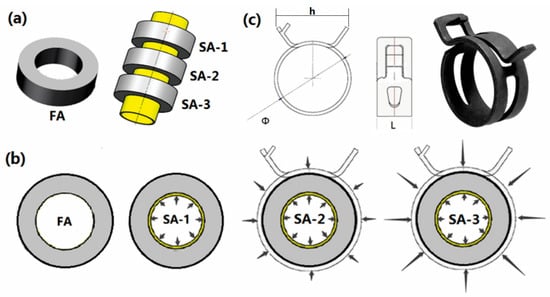
Figure 1.
(a,b) Schematic representations of the four categories of samples (FA, SA-1, SA-2, and SA-3) prepared to apply various extents of stress. (c) An illustration of the spring band clamp utilized to apply radial stresses on the as-wound cores. The bandwidth of clamps (L) is 12 mm.
In the other two categories (samples SA-2 and SA-3 in Figure 1a), the wound cores were first kept in contact with the steel tube. Subsequently, spring band hose clamps (see Figure 1c) were used to introduce compressive radial stresses on the outer layer of cores. In this regard, diameters of ϕ = 29 mm for SA-2 samples and ϕ = 27 mm for SA-3 samples were expanded by pliers and then were released and put in direct contact with the outer surface of the as-wound cores (see Figure 1b). Since hose clamps had a smaller inner diameter than the as-wound cores, the cores were contracted and radial compressive stress was imposed on them. Due to the inhomogeneous contact between hose clamp and cores, a thin steel sheet was placed between them to make the applied radial stress on cores more uniform.
After the preparation of samples, the nanocrystallization heat treatment was conducted at the temperature of 813 K for 1 h under vacuum atmosphere.
The structure of treated cores in the outermost layer was analyzed by X-ray diffraction (XRD, Bruker D8, Karlsruhe, Germany) with Cu-Kα radiation. In particular, the size of crystallites formed during annealing treatment and the amount of microscopic strain in treated samples were calculated using Rietveld refinement method [17].
The soft magnetic properties were characterized using DC (direct-current) B–H hysteresis tracer (MATS–2010SD, Hunan, China). The coefficient of inductance at various frequencies was measured using an LCR meter (TH–2829CX, Zhejiang, China). The AC core loss properties of treated cores were measured by a Electrical steel tester (Brockhaus MPG200, Nieland, Germany) setup operating at different induction fields and frequencies.
3. Result and Discussion
3.1. Analysis of Strain in Stress-Annealed Samples
The amount of tensile strain in SA-1, SA-2, and SA-3 samples can be estimated by the following equation:
where α is the coefficient of thermal expansion and ΔT is the temperature rise. Considering α = 18.7 µm/m K for stainless steel tube and ΔT = 515 °C (temperature increase from 25 °C to 540 °C), the amount of tensile strain imposed on the inner layer is ~1%.
In SA-2 and SA-3 samples, the amount of compressive strains can be approximated by measuring the difference in the value of h (see Figure 1c) before and after placing the as-wound core inside the clamps. Since the outer diameter of the wound core is larger than the inner diameter of clamps, the clamp’s circumference increases by an absolute amount of Δh and, consequently, the radius of clamp increases by an amount of Δr. Δh and Δr are related by Δr = Δh/2π. The change in the amount of clamp’s inner radius (Δr) gives rise to compressive radial strain in the outer layer of the wound core because of the spring nature of clamp. The amounts of Δr in clamps used in SA-2 and SA-3 samples are, respectively, 0.318 mm and 0.605 mm, and the imposed strain on the outer layer of the as-wound cores is estimated to be ~1.76% in SA-2 sample and 3.58% in SA-3 sample.
It should be noted that tensile and compressive stresses imposed respectively on the inner and outer layers of the wound core will be gradually decreased layer by layer in the tape wound core due to the finite stacking factor of wound core [18]. Therefore, stress distribution and the consequent anisotropies induced by stress are not uniform throughout the stress-annealed cores.
3.2. Structural Characterizations
The XRD plots for treated samples are shown in Figure 2a. Annealing at 813 K for 1 h yields primary crystallization of as-cast amorphous samples, and, consequently, a heterogeneous structure containing nanocrystalline phases and the amorphous matrix is formed [19]. Analysis of diffraction peaks revealed that the main phase crystallized in all samples during annealing treatment was Fe3Si phase. This phase is a soft magnetic phase with face-centered cubic (D03) structure, which belongs to Fm-3m space group [20]. In addition to Fe3Si phase, a small peak representing the crystallization of elemental Si phase was also detected. This observation is in line with the previously reported XRD phase analysis for Finemet alloy [21]. The size of crystallites and the values of microstrains developed in samples are determined from XRD plots and shown in Figure 2b. The value of microstrain is ~0.14% for all treated samples, and is independent of the annealing treatment procedure. This amount of strain is significantly lower than the values of microscopic strain (~0.9%) determined from in-situ measurements during tensile stress annealing of Finemet ribbons [22]. Further, the size of Fe3Si crystallites is about 15–16 nm for all samples and it is independent of the extent of stress annealing treatment. It was reported previously that annealing of FeCuNbSiB amorphous alloys under tensile stresses can decrease average grain sizes by ~20% [23]. These results suggest that radial stresses imposed on wound cores are not large enough to significantly alter the structural characteristics of Fe3Si phase during nanoscrysatllization. In addition, structural evolution of nanocrystalline soft magnetic alloys during annealing treatment depends mainly on annealing temperature and time [1]. Since these parameters are similar for all treated samples, the observation of identical structural features is expected.
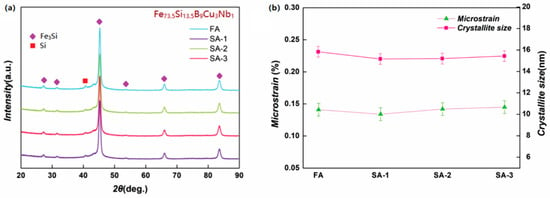
Figure 2.
(a) XRD plots for nanocrystalline soft magnetic cores annealed at different conditions. (b) The microstrain and crystallite size as a function of the extent of stress annealing.
3.3. DC B–H Hysteresis Loops
Figure 3a shows the DC hysteresis loops for the treated magnetic cores without and with external radial stresses. While the core without external stress (FA) shows a squared B–H loop, the other treated cores show sheared hysteresis loops. This observation indicates that excess magnetic anisotropy is induced in samples by stress annealing [24].
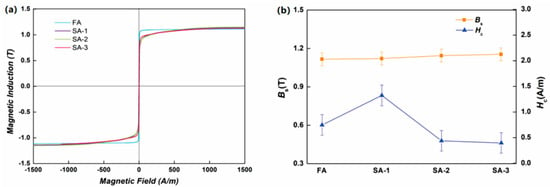
Figure 3.
(a) DC (direct-current) hysteresis loops of Finemet-type magnetic cores annealed at 813K for 1h without and with radial stresses. (b) The values of Bs and Hc for different samples.
The values of Bs and Hc measured from B–H hysteresis curves are shown in Figure 3b. It can be seen that the values of Bs in all treated cores are almost identical, implying that stress annealing has no remarkable effect on Bs. This finding is also in line with the XRD results where the crystallite size was independent of stress annealing treatment. Moreover, Hc value in sample SA-1 is slightly higher than sample FA, and in samples SA-2 and SA-3, Hc decreases to values slightly lower than FA. However, the changes in Hc occur over a narrow range and can be negligible in the case of toroidal cores.
The squareness of B–H hysteresis curves can be quantified using the Br/Bs ratio (Br is the magnetic remanence). As shown in Figure 4, the Br/Bs ratio decreases with the increase in the extent of stress annealing. As stress annealing can induce magnetic anisotropy in the alloy, it can, therefore, change the Br/Bs ratio.
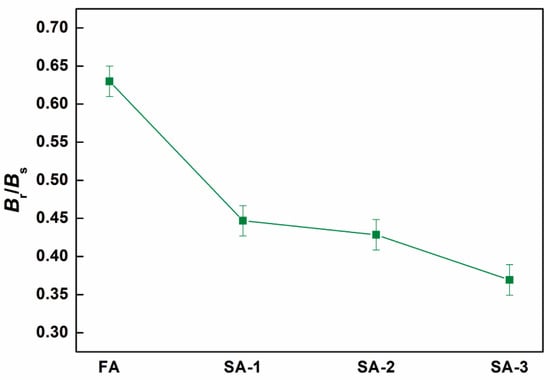
Figure 4.
Squareness ratio (Br/Bs) determined from DC hysteresis loops.
Generally, transverse magnetic annealing can induce lateral magnetic anisotropy in the material and reduce Br of the alloy. As the values of Bs are similar in all treated samples (see Figure 3b), the decrease in Br/Bs ratio is equivalent to the reduction of Br. So, the significantly lower Br values of stress-annealed magnetic core (SA-1, SA-2, and SA-3) compared to the FA sample indicates that the alloy under stress annealing has transverse magnetic characteristics. In other words, after stress annealing, the easy magnetization axis of the alloy is deflected, and the lateral magnetic anisotropy is induced inside the treated core. Therefore, it can be inferred that large magnetic anisotropies are produced in the sample as the extent of stress is increased.
3.4. Induced Anisotropy
Magnetic anisotropy is a measure of the resistance of the magnetic material against the magnetization process, and it can be quantified using the following equation [25]:
where Ku is the magnetic anisotropy energy, H is the magnetic field, and Ms is the magnetization saturation. Figure 5 shows the absolute values of Ku in treated samples. While Ku in the FA sample is as small as ~20 J/m, the value of Ku remarkably increases in stress-annealed samples. The value of Ku in the FA sample is comparable to the low values of Ku reported for Fe73.5Si13.5B9Cu3Nb1 (at. %) ribbons during magnetic field-assisted annealing at the same thermal protocol [26]. This small amount of magnetic anisotropy found in sample FA may have geometrical origins. It has been shown that winding as-cast ribbons to toroidal cores of 15-mm and 25-mm inner diameter can result in more considerable bending stresses in the core with lower diameter (i.e., 15-mm inner diameter) [27], which will further influence the magnetization process and other magnetic properties in the wound core.
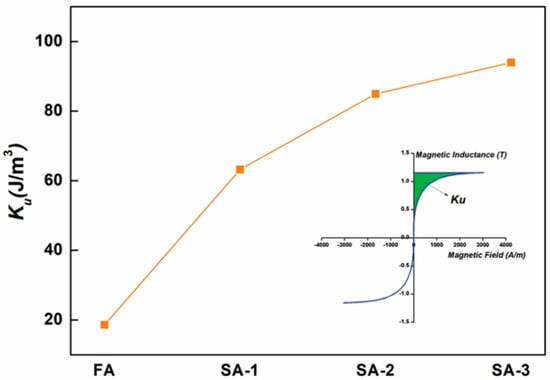
Figure 5.
Magnitude of stress-induced magnetic anisotropy in treated samples. The inset illustrates the method for calculation of Ku.
In the case of stress-annealed samples, Ku increases remarkably to values ~3–5 times larger than the FA sample. Additionally, the increase in Ku is monotonic with the extent of stress annealing treatment. This finding also corroborates that imposed stress in sample SA-3 is larger than the stresses generated in samples SA-2 and SA-1, since the amount of magnetic anisotropy energy is proportional to the amount of stress [13].
Note that the tape-wound cores also shrink during annealing treatment due to the amorphous-to-nanocrystalline transition by ~1% [17]. This shrinkage of the core, supported by the large thermal expansion of the steel tube, induces radial tensile stresses that yield easy magnetization axis perpendicular to the length of the wound core [17]. The magnetic anisotropy induced in stress-annealed samples may have a magneto-elastic origin. When Fe3Si is crystallized in the presence of stress, the anelastic polarization of the amorphous matrix generates back stresses in the Fe3Si nanograins and the magneto-elastic interactions between crystallites and the amorphous matrix bring to magnetic anisotropy [13].
3.5. Coefficient of Inductance (Effective Permeability)
Since magnetic permeability of the magnetic core is much higher than the magnetic permeability of the surrounding air, the magnetic flux is confined in the magnetic circuit when an inductive coil is applied. The inductance (L) of the coil is [28]
where N is the number of turns, μr is the relative permeability, μ0 is the permeability of free space, and A and l are the area and length of the coil, respectively. The coefficient of inductance is the single-turn inductance, written as
It can be seen that the relative permeability is proportional to the inductance, and the change in the relative permeability can be characterized by monitoring the changes in the inductance. Figure 6 shows the changes in the coefficient of inductance at different switching frequencies. Over a wide frequencies range, the coefficient of inductance (i.e., μr) remarkably decreases as the stress is increased in samples. The decline of inductance for different frequencies in the sample SA-3 is as much as ~50% of the inductance in the sample FA (without stress). Accordingly, the method used in this study successfully reduced magnetic permeability of stress-annealed cores.
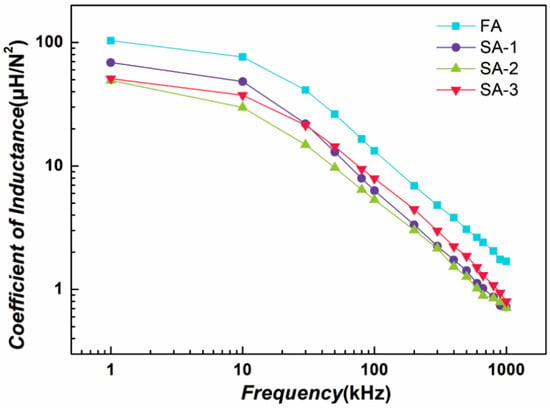
Figure 6.
Frequency dependency of coefficient of inductance (effective permeability) in annealed samples.
The reason for the observation of lower permeability in stress-annealed samples is that a transverse magnetic anisotropy is induced in the nanocrystalline alloy after stress annealing, and, consequently, it becomes difficult to magnetize the alloy in the direction of the magnetization field and the magnetic permeability is diminished [29]. Therefore, magnetic permeability of nanocrystalline cores can be tuned over a wide frequency range by stress annealing treatments during crystallization [1]. This is the distinct advantage of nanocrystalline soft magnetic alloys over the conventional gapped ferrite cores in which the control of inductance is confined by the fixed core geometry [30].
3.6. Core Losses in Treated Samples
The AC core loss (Ps) for annealed samples is shown in Figure 7. It can be seen from Figure 7a that the Ps in all samples increases as the strength of the magnetic field increases, mainly because more immense energy is required for the magnetic core to provide an increase in induction near the saturation [1]. The Ps also increases with increasing frequency in all samples (see Figure 7b), due to eddy current losses at higher frequencies and the dynamic motions of the magnetic domain walls [2]. In the case of stress-annealed samples, the values of Ps at constant frequency (Figure 7a) or constant magnetic field (Figure 7b) have slightly larger amounts than the sample FA. This increase of Ps in stress-annealed samples might be due to the influences of imposed stresses on the pinning of domains wall and subsequent increase in the coercive field, which eventually increases the hysteresis losses [27]. However, it should be noted that the variations of Ps in stress-annealed samples are marginal and occur in a range that is expected for Finemet-type nanocrystalline soft magnetic alloys [1].
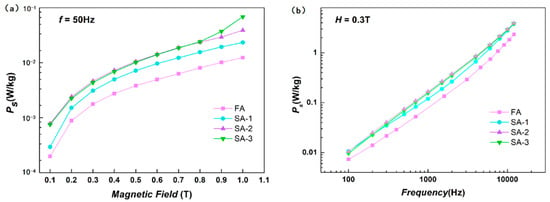
Figure 7.
(a) The magnitude of core loss (Ps) at different magnetic fields (constant frequency of 50 Hz). (b) The magnitude of core loss at different frequencies (constant magnetic field of 0.3 T).
4. Conclusions
By applying external stress to the toroidal cores prepared from Fe73.5Si13.5B9Cu3Nb1 ribbons, the soft magnetic properties and structure of treated samples were studied. We found that the size of crystallites and microstrains in treated samples is independent of the extent of applied stress, and the magnetic properties is influenced by the stress annealing treatment. The B-H curves get flattened and the Br/Bs ratio becomes smaller as larger stresses are imposed. The applied stress also changes the magnetic anisotropy energy of the stress-annealed nanocrystalline magnetic cores. Stress leads to magnetoelastic anisotropy, which in turn induces anisotropy. By inducing magnetic anisotropy, magnetic permeability can be adjusted over a wide range in treated samples and iron loss increases slightly. These findings suggest that the application of radial stresses can effectively influence the magnetic properties in Finement-type nanocrsyatlline toroidal cores.
Author Contributions
Conceptualization: Z.X. and W.W.; methodology: X.L. and S.S.; resources: Y.R. and W.W.; writing-original draft preparation: X.L.; writing-review and editing: X.L. and S.S.; project administration: Z.X., Y.R. and W.W. All authors have read and agreed to the published version of the manuscript.
Funding
This work was funded by the National Key Research and Development Program of China (Grant No. 2017YFB0903903) and the National Natural Science Foundation of China (Grant No. 51971092).
Conflicts of Interest
The authors declare that they have no conflict of interest.
References
- Willard, M.A.; Daniil, M. Nanocrystalline Soft Magnetic Alloys Two Decades of Progress. In Handbook of Magnetic Materials; Buschow, K.H.J., Ed.; Elsevier: Amsterdam, The Netherlands, 2013; Volume 21, pp. 173–342. [Google Scholar]
- Huang, B.; Yang, Y.; Wang, A.D.; Wang, Q.; Liu, C.T. Saturated magnetization and glass forming ability of soft magnetic Fe-based metallic glasses. Intermetallics 2017, 84, 74–81. [Google Scholar] [CrossRef]
- Inoue, A.; Shen, B. Soft magnetic bulk glassy Fe-B-Si-Nb alloys with high saturation magnetization above 1.5T. Mater. Trans. 2002, 42, 766–769. [Google Scholar] [CrossRef]
- Wang, F.; Inoue, A.; Han, Y.; Kong, F.L.; Zhu, S.L.; Shalaan, E. Excellent soft magnetic Fe-Co-B-based amorphous alloys with extremely high saturation magnetization above 1.85 T and low coercivity below 3 A/m. J. Alloy. Compd. 2017, 711, 132–142. [Google Scholar] [CrossRef]
- Luborsky, F.; Becker, J.; Walter, J.; Martin, D. The Fe-B-C ternary amorphous alloy. IEEE Trans. Magn. 1980, 166, 521–525. [Google Scholar] [CrossRef]
- Hasegawa, R. Advances in amorphous and nanocrystalline magnetic materials. J. Magn. Magn. Mater. 2006, 304, 187–191. [Google Scholar] [CrossRef]
- Willard, M.R.; Daniil, M. Nanostructured soft magnetic materials. In Nanoscale Magnetic Materials and Applications; Liu, J.P., Fullerton, E., Gutfleisch, O., Sellmyer, D.J., Eds.; Springer Science: New York, NY, USA, 2009. [Google Scholar]
- McHenry, M.E.; Willard, M.A.; Laughlin, D.E. Amorphous and nanocrystalline materials for applications as soft magnets. Prog. Mater. Sci. 1999, 44, 291–433. [Google Scholar] [CrossRef]
- Ramin, D.; Riehemann, W. Dependence of magnetic properties of finemet on nanocrystallisation conditions. Nanostruct. Mater. 1999, 12, 867–869. [Google Scholar] [CrossRef]
- Ito, N.; Suzuki, K. Improvement of magnetic softness in nanocrystalline soft magnetic materials by rotating magnetic field annealing. J. Appl. Phys. 2005, 97, 10F503. [Google Scholar] [CrossRef]
- Allia, P.; Baricco, M.; Knobel, M.; Tiberto, P.; Vinai, F. Nanocrystalline Fe73.5 Cu1Nb3Si13.5B9 obtained by direct-current Joule heating. Magnetic and mechanical properties. Philos. Mag. B Phys. Condens. Matter 1993, 68, 853–860. [Google Scholar] [CrossRef]
- Yoshizawa, Y.; Yamauchi, K. Effects of magnetic field annealing on magnetic properties in ultrafine crystalline Fe-Cu-Nb-Si-B alloys. IEEE Trans. Magn. 1989, 25, 3324–3326. [Google Scholar] [CrossRef]
- Herzer, G. Creep induced magnetic anisotropy in nanocrystalline Fe-Cu-Nb-Si-B alloys. IEEE Trans. Magn. 1994, 30, 4800–4802. [Google Scholar] [CrossRef]
- Hofmann, B.; Kronmüller, H. Stress-induced magnetic anisotropy in nanocrystalline FeCuNbSiB alloy. J. Magn. Magn. Mater. 1996, 152, 91–98. [Google Scholar] [CrossRef]
- Yanai, T.; Shimada, A.; Takahashi, K.; Nakano, M.; Yoshizawa, Y.; Fukunaga, H. Magnetic properties of Fe-based ribbons and toroidal cores prepared by continuous Joule heating under tensile stress. IEEE Trans. Magn. 2006, 42, 2781–2783. [Google Scholar] [CrossRef][Green Version]
- Csizmadia, E.; Varga, L.K.; Palánki, Z.; Zámborszky, F. Creep or tensile stress induced anisotropy in FINEMET-type ribbons? J. Magn. Magn. Mater. 2015, 374, 587–590. [Google Scholar] [CrossRef]
- Rietveld, H. A profile refinement method for nuclear and magnetic structures. J. Appl. Crystallogr. 1969, 2, 65–71. [Google Scholar] [CrossRef]
- Günther, W. Stress annealing process suitable for the production of low permeable nanocrystalline tape wound cores. J. Magn. Magn. Mater. 2005, 290, 1483–1486. [Google Scholar] [CrossRef]
- Herzer, G. Grain structure and magnetism of nanocrystalline ferromagnets. IEEE Trans. Magn. 1989, 25, 3327–3329. [Google Scholar] [CrossRef]
- Kulik, T.; Żuberek, R.; Hernando, A. Magnetic properties of nanocrystalline Fe73.5Cu1Nb3Si16.5B6. J. Magn. Magn. Mater. 1995, 140, 433–434. [Google Scholar] [CrossRef]
- Ri, M.C.; Sun, Y.H.; Xue, Z.Y.; Ding, D.W.; Wang, W.H. Determination of internal residual strain induced by cryogenic thermal cycling in partially-crystalized Fe-based metallic glasses. J. Alloy. Compd. 2018, 781, 357–361. [Google Scholar] [CrossRef]
- Nutor, R.K.; Fan, X.; He, X.; Xu, X.; Lu, X.; Jiang, J.; Fang, Y. Formation mechanism of stress-induced anisotropy in stress-annealed Fe-based nanocrystalline ribbon alloys. J. Alloy. Compd. 2019, 774, 1243–1249. [Google Scholar] [CrossRef]
- Fan, X.Z.; He, X.W.; Nutor, R.K.; Pan, R.M.; Zheng, J.J.; Ye, H.Q.; Wu, F.M.; Jiang, J.Z.; Fang, Y.Z. Effect of stress on crystallization behavior in a Fe-based amorphous ribbon: An in situ synchrotron radiation X-ray diffraction study. J. Magn. Magn. Mater. 2019, 469, 349–353. [Google Scholar] [CrossRef]
- Herzer, G.; Budinsky, V.; Polak, C. Magnetic properties of FeCuNbSiB nanocrystallized by flash annealing under high tensile stress. Phys. Status Solidi B 2011, 248, 2382–2388. [Google Scholar] [CrossRef]
- Williams, R.; Egami, T. Effects of deformation and annealing on magnetic amorphous alloys. IEEE Trans. Magn. 2003, 12, 927–929. [Google Scholar] [CrossRef]
- Herzer, G. Magnetic field-induced anisotropy in nanocrystalline Fe-Cu-Nb-Si-B alloys. J. Magn. Magn. Mater. 1994, 133, 248–250. [Google Scholar] [CrossRef]
- Shuvaeva, E.; Kaloshkin, S.; Churyukanova, M.; Perminov, A.; Khriplivets, I.; Mitra, A.; Panda, A.K.; Roy, R.K.; Premkumar, V.; Zhukova, A. The impact of bending stress on magnetic properties of Finemet type microwires and ribbons. J. Alloy. Compd. 2018, 743, 388–393. [Google Scholar] [CrossRef]
- Fuchs, E.F.; Masoum, M.A.S. Magnetic circuits: Inductors and permanent magnets. In Power Conversion of Renewable Energy Systems; Springer: Boston, MA, USA, 2011; pp. 217–287. [Google Scholar]
- Wu, Y.Q.; Bitoh, T.; Hono, K.; Makino, A.; Inoue, A. Microstructure and properties of nanocrystalline Fe-Zr-Nb-B soft magnetic alloys with low magnetostriction. Acta Mater. 2001, 49, 4069–4077. [Google Scholar] [CrossRef]
- Fukunaga, H.; Tanaka, H.; Yanai, T.; Nakano, M.; Takahashi, K.; Yoshizawa, Y. High performance nanostructured cores for chock coils prepared by using creep-induced anisotropy. J. Magn. Magn. Mater. 2002, 242, 279–281. [Google Scholar] [CrossRef]
© 2020 by the authors. Licensee MDPI, Basel, Switzerland. This article is an open access article distributed under the terms and conditions of the Creative Commons Attribution (CC BY) license (http://creativecommons.org/licenses/by/4.0/).